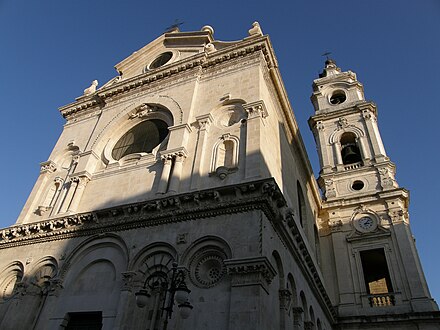Foggia - Italian comune
Foggia is a city in Apulia (Puglia) in Italy.
Understand
Foggia is the capital of the province of Foggia in the Puglia region. The area is known for agriculture: olives, grains, grapes, and Buffalo Mozzerella. The population is about 150,000.
Get in
By plane
Gino Lisa Airport is linked to only a few Italian towns, but you can fly into Rome, Naples or Bari instead. Bari is the closest.
By train
There are good connections from Rome in 3½ hours or a high-speed train from Milan will get you there in just under 7 hours.
- Foggia railway station (Stazione di Foggia). 2020-11-20
By car
The train station is a block away from a National rental car office.
By bus
The bus station is just in front of the railway station. AirBus (dead link: January 2023) directly connects Foggia to two Campania cities: Naples and Ariano Irpino.
By boat
Get around
See
Take a walk in the Old Town along via Arpi from via Fuiani until the end where you find the 3 Archi (the remains of the old walls of the town). Explore the little streets and squares adjacent along the way, along with the Cathedral.
Do

Also, Foggia is close to Lucera, an old walled city, and adjacent to the Gargano peninsula.
Buy
Eat
There is an abundance of restaurants in Foggia. There are several nice restaurants around the Old Town.
Budget
Mid-range
- Da Nino al Grottino, Teatro 13 (on the edge of "Old Town", around the corner from the Teatro). This is a fun pizza place with a nice antipasta spread. It is often packed after 20:30. Wood fired pizza oven and good service. 2022-02-18
- Giordano Da Pompeo, Vico al Piano 14 (on the opposite side of the Teatro). A nice restaurant with white linen table cloths. 2022-02-18 is
- Del Cacciatore Di Gaetana, v. Mascagni 12 (just a block from Grottino). A family-style restaurant that has great food. 2022-02-18
- Nenna Nè, Via Cirillo Domenico, 18, 71121 Foggia FG, +393200814931. Traditional food using only local ingredients. 2022-02-18
Splurge
- Casa Nik, Via Saverio Altamura, 23, +39 0881 775856. Here you could have some prosciutto or a seafood pasta dish or simply some wine and dessert, and enjoy the street scene from your table.
Drink
Sleep
Budget
Mid-range
- Hotel Mercure Cicolella. This hotel is next to the train station, rental car agency and downtown businesses. The hotel has high speed internet for an extra fee and breakfast is included. The rooms facing inside are quieter.
Splurge
Connect
Stay safe
Cope
Go next
Naples, the ancient Kingdom's capital, and Campania region are not far from Foggia. Ariano Irpino (named as Ariano in Apulia until 1930) is a characteristic town located astride Apennines along the statal road SS90 (formerly the national Apulia's road) connecting Foggia to Naples. Ariano Irpino (60 km from Foggia) was a relevant city in the Middle Age within the Duchy of Apulia: there King Roger II convened the Assizes of Ariano in 1140 and minted ducats. Today Ariano Irpino preserves the Norman Castle where King Roger II lived in; the castle, surrounded by a wide public park, still overlooks the mountain pass between Apulia and Campania with very panoramic views. Within the castle is housed a Norman Museum with other museums and churches (particularly the Romanic Cathedral) being scattered in the town, where both local art and cuisine mingle Apulian and Campanian elements.
Foggia
comune.foggia.itProvince of Foggia
2nd-order administrative division
Apulia
Primary administrative division